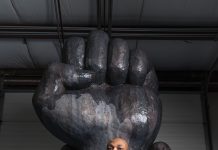
How does a British artist go about trying to capture the cultural DNA of a city as complex as Detroit when he has no local roots and lives more than 3,700 miles away? Turns out it takes both audacity and humility, and it takes buy-in from locals who see the value in telling the stories of the city’s people with authenticity.
Marcus Lyon decided to take on that challenge after a chance meeting with The Fisher Group CEO Mark Davidoff at a 2017 conference in Northern England. The two discussed their lives and Lyon’s family in Traverse City, and Lyon shared with Davidoff his previous Human Atlas projects that explored the people of specific regions in Brazil and Germany. Impressed, Davidoff wanted to bring that project to Detroit. The result, three years later, is i.Detroit — A Human Atlas of an American City, a remarkable multimedia project Lyon unveiled in mid-October as a photo book, website, and app.
The project began with a six-month nomination process, during which Lyon and 14 community elders and leaders chose 100 people, or “i.Detroiters,” who are making an impact in the city and beyond. Lyon made sure those featured in the project reflected the city’s nearly 80 percent Black population. Funded by The Kresge Foundation and supported by The Charles H. Wright Museum of African American History, the project goes beyond a standard photography book. Lyon and his team created an audio oral history of each i.Detroiter’s interview that can be heard directly at ahumanatlas.com, or activated by scanning their portraits through the free i.Detroit app. They also collected and analyzed each i.Detroiter’s DNA to map their ancestries and trace their generational migration to Detroit. And, in an homage to the city’s musical influence, each i.Detroiter chose a track for the i.Detroit Spotify playlist.
Hour Detroit spoke with Lyon from his London design studio about his experiences with the city before and after i.Detroit, how he’s made the project more accessible beyond the book, and what he hopes people will take away from it.

Hour Detroit: What did you know of Detroit before this project?
Marcus Lyon: The DIA, occasional trips flying into Detroit, and then hiring a car to go up and see my stepsister who lives in Traverse City. So, not a great deal. My childhood was peppered with the sounds of Motown. Techno was something that kind of hit the scene when I was at university. So, there was a kind of musical theme there. But I think the real Detroit was a mystery to me.
Did you encounter any resistance when you met with community leaders to pitch this project?
I got a proper grilling. It’s like, “Why you? Why a white man? Why an Englishman? What do you think you know that means you can tell our story properly? What are your intentions? How are you going to do this?” I just answered super authentically, super honestly — that I came to listen. I came to tell the story. I told them how we like to tell stories through people’s own voices. Each of the portraits I take has a soundscape associated with it. So, I think people got that, and at the end of the meeting, they said, “All right, we’re in. Count us in. How can we help you make this happen?”
What did you learn about the i.Detroiters’ ancestral histories while doing the DNA mapping?
I think it tells you a very deep story about America’s original sin: slavery. The movement of Africans across the Atlantic and into the Americas. It’s all dark, really. It’s all difficult, it’s all complicated, but there’s a huge amount of European blood mixed in with the African American population of North America. Those are difficult stories, but I think that so many of our Black, our African American, friends in the i.Detroit project who stepped up found that relationship to real knowledge about who they were and where they were from was a really powerful and life-enhancing process. … The other thing that I think is a lovely connection story is two of the people who were in the book have subsequently found out through that DNA testing that they are actually related.
How do you plan on making i.Detroit more accessible?
It’s work we’ve done alongside and actually unfunded by Kresge, but funded by my own studio. We built a website called ahumanatlas.com, and all the DNA, sounds, and images are there on that website free to everyone — open source, open access. There is no barrier to entry. It was very important to me, and I think we would have really missed the point if we hadn’t done that.
What did you learn about the city while completing i.Detroit?
The DNA told me that we’re all brothers and sisters. The soundtracks told me that we were really researching and telling the stories of an exceptional group of human beings. And the portraits were just pure joy for me to make. In terms of those three elements, I suppose the takeaways from Detroit were very much about resilience in the face of adversity.
What do you hope people will take away from the project?
I hope, especially, young people have a really clear sense that there are heroes in the next-door street or in the next-door house. That their community is good enough for them to give their service to and for them to step up and create a more hopeful future. I hope people who get to see the project realize that Detroit is not some kind of drug-crazed, violent, post-industrial apocalyptic kind of dystopia, but it’s a real, functioning city with amazing people doing extraordinary things, often against the odds.
To learn more about i.Detroit and listen to i.Detroiters’ stories, download the free i.Detroit app or visit ahumanatlas.com.
|
|
|













